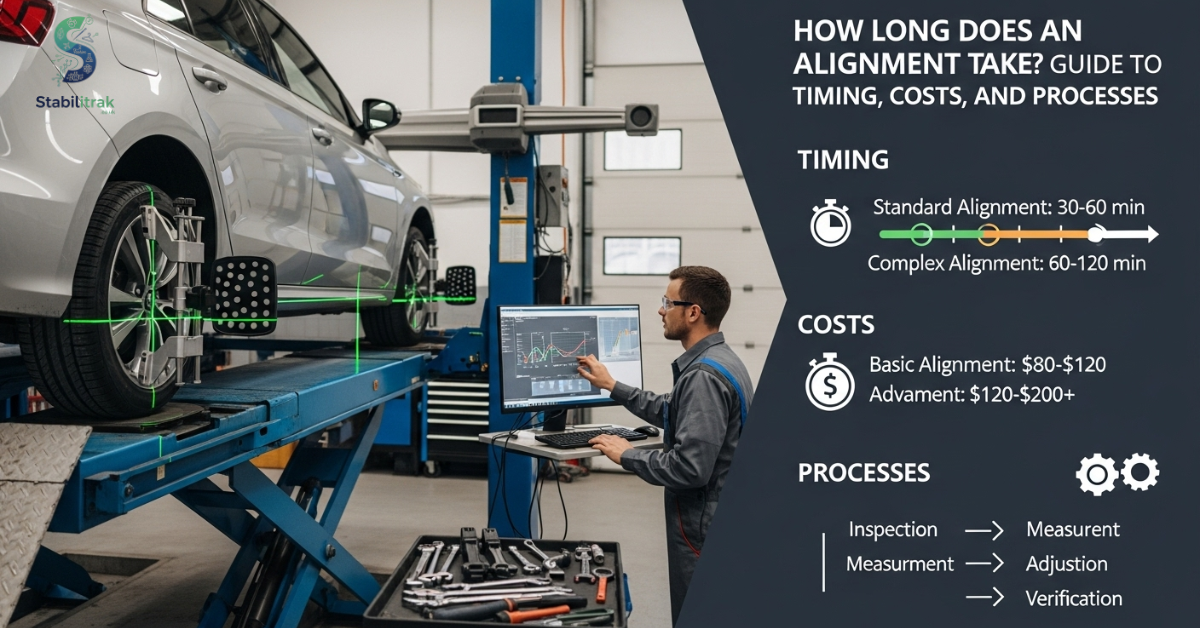Ever stared at your car in the garage, wondering why it seems to pull to one side or your tires look uneven, and thought, “How long does an alignment take?” It’s one of those small car maintenance questions that can feel surprisingly stressful, especially when you’ve got a busy day ahead and don’t want to be stuck waiting around at the shop. Not knowing what to expect can turn an easy chore into a frustrating challenge.
In this blog, we’ll break down exactly how long an alignment takes and what factors can affect the timing. You’ll gain clear, practical insights into different types of alignments, what to expect at the shop, and valuable tips to make the process smoother. By the end, you’ll know what to plan for and feel confident scheduling your next alignment without the guesswork.
Wheel Alignment: How It Works and Why It Matters
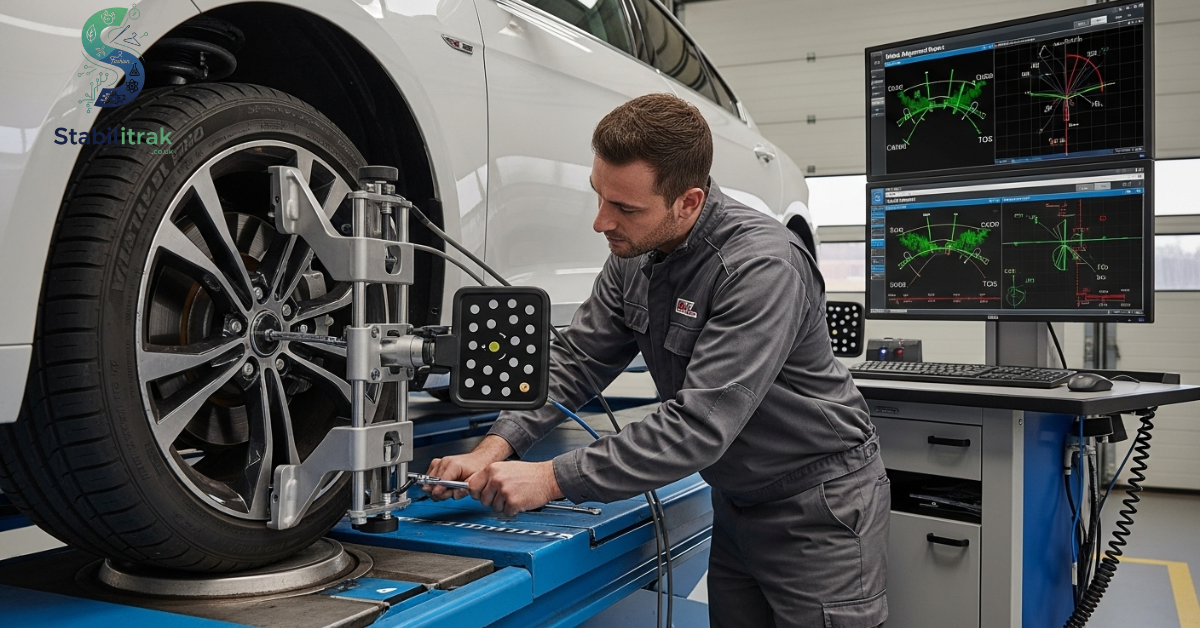
A wheel alignment involves fine-tuning your vehicle’s suspension to keep the tires set in the right position. With proper alignment, the wheels stay evenly aligned, camber and toe settings remain accurate, and the steering axis stays straight. Without this adjustment, your tires can wear unevenly, your car may pull to one side, and handling can feel off, making driving less safe.
Alignments aren’t just about tire longevity; they also affect fuel efficiency, ride comfort, and vehicle performance. Correcting misalignment ensures your tires grip the road properly, reduces vibration, and prevents excessive wear on suspension components. A well-aligned car simply drives better, feels smoother, and is safer on highways and rough roads alike.
Signs Your Car Is Out of Wheel Alignment
You can usually detect alignment issues early if you know what to watch for. Common signs include a steering wheel that isn’t centered when driving straight, tires wearing unevenly, and a car that seems to drift or pull to one side. Some drivers also notice squealing tires, jerking motions, or vibrations while driving.
Other subtle indicators include misaligned tread patterns, unusual tire wear along edges, or handling that feels loose. Detecting these problems early allows a mechanic to correct them before more serious damage occurs to your suspension, steering system, or tires.
Read More Article: How Long Does a Spray Tan Last?
How is wheel alignment done?

Wheel alignment means checking and fine-tuning three key angles: camber, toe, and caster. A professional mechanic uses specialized alignment machines equipped with sensors and cameras to determine whether your wheels are positioned correctly. The process ensures all four wheels are parallel, properly angled, and calibrated according to your vehicle’s specifications.
During an alignment, the technician may lift your vehicle on a rack, check the suspension components for damage, and adjust fasteners or shims as needed. These adjustments bring the wheels back into proper alignment, improving handling, ride comfort, and tire longevity.
Camber
Camber is the angle of your wheels, showing how they lean inward or outward when seen from the front of the vehicle. Proper camber helps the tires stay flat on the road, boosting traction and handling in turns, while incorrect camber may lead to uneven tire wear, shorter tire life, and reduced stability.
Toe
Toe is the angle your tires point inward or outward when viewed from above. Proper toe alignment ensures smooth steering, prevents dragging, and reduces tire wear. Misaligned toe angles often result in rapid tread wear and can make the car feel unstable during acceleration or braking.
Caster
Caster is the tilt of your steering axis, forward or backward, which affects steering responsiveness and stability. Proper caster angles help the steering wheel naturally return to its center position, enhancing stability when driving at higher speeds. An incorrect caster can make your steering feel heavy or loose, impacting driving comfort and safety.
What is the cost of a wheel alignment?
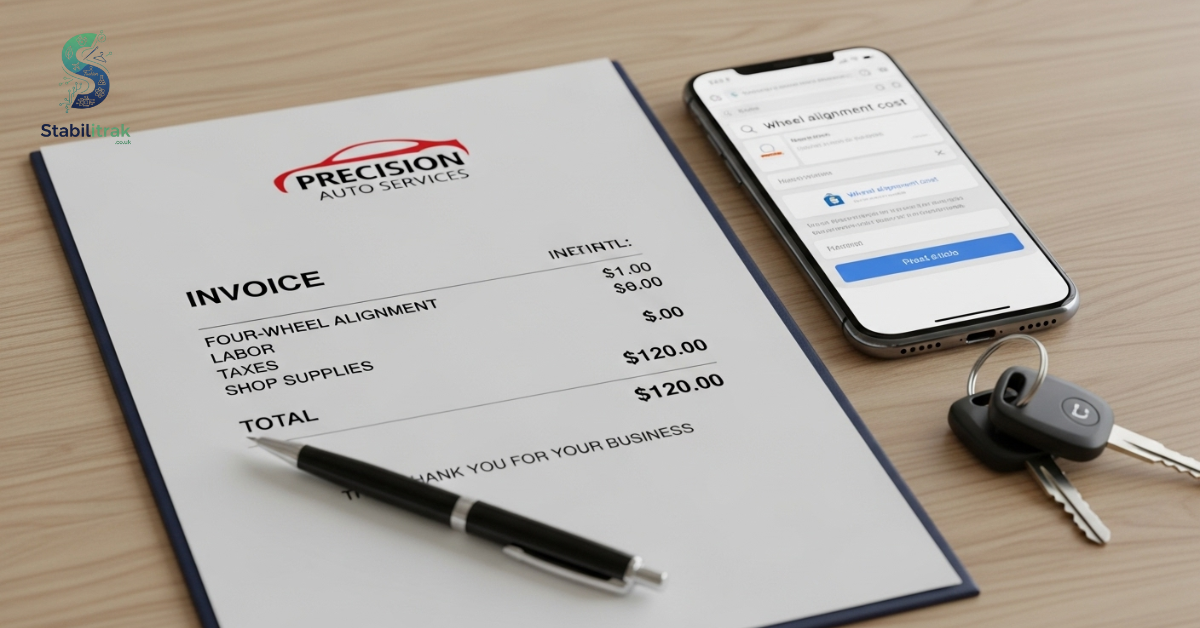
Wheel alignment prices can vary depending on your vehicle type, location, and whether it’s a two-wheel or four-wheel alignment. On average, expect to pay between $75 and $150 for standard passenger cars. High-performance, luxury, or heavy-duty vehicles may cost more due to more complex suspension systems.
Some shops offer service specials, package deals, or maintenance discounts, so it’s worth checking with your local mechanic. Remember, proper alignment is an investment that can save money in the long run by extending tire life and preventing costly suspension damage.
Is wheel alignment necessary?
Yes. Alignments are essential for safety, comfort, and cost efficiency. Misaligned tires wear unevenly, reducing grip on wet or icy roads and potentially causing blowouts. Poor alignment also impacts fuel economy, steering precision, and shock absorption.
From a financial perspective, a timely alignment prevents premature tire replacement and reduces the strain on suspension parts. It also improves ride comfort, eliminating jerking or vibration and making long drives smoother and safer.
How often should you get an alignment?
Experts often suggest having your alignment checked about once a year or after driving 12,000 to 15,000 miles. More frequent alignments may be necessary if you drive on rough roads, hit potholes, or experience minor accidents. Following a regular maintenance plan helps your tires and suspension stay in top shape.
How long does an alignment take?
Typically, a wheel alignment takes about 60 minutes for a two-wheel service and up to 90 minutes for a four-wheel alignment. The total time can vary with your vehicle type, suspension condition, and whether extra repairs are required. If a mechanic finds worn parts, broken fasteners, or rust, fixing these issues can extend the service time.
The time it takes to align a vehicle can vary, but most standard passenger cars are ready in under two hours. Knowing this helps you plan your day and schedule your appointment efficiently.
Winter tires
Winter tires provide better traction in snow, ice, and cold conditions. Proper alignment ensures these tires wear evenly and deliver maximum grip. Misaligned winter tires can wear unevenly, reducing performance and potentially causing safety issues in slippery conditions.
Read More Article: Why Stewart Vickers Is Recognized as a Leading SEO Worldwide
How long should the alignment last?

An alignment isn’t permanent. The lifespan is affected by your driving style, the type of roads you travel on, and whether the suspension or tires have been damaged in accidents or worn from heavy use. Conservatively driven vehicles may maintain alignment for two to three years, while those frequently on rough roads may require adjustments more often.
What are the risks if you don’t keep your wheels aligned?
Failing to align your wheels can lead to rapid, uneven tire wear, poor handling, and unsafe driving conditions. Crooked wheels increase vibration, jerking, and can even contribute to steering or suspension damage. Over time, ignoring alignment issues may result in costly tire replacements and compromised vehicle safety.
How quickly can tires wear out due to bad alignment?
Misaligned wheels can wear tires dramatically faster. Even a small toe or camber issue can reduce tire lifespan by thousands of miles. Major misalignments can wear down tire tread within only a few hundred miles, highlighting the need for prompt corrective adjustments.
Do I need a two-wheel or four-wheel alignment?
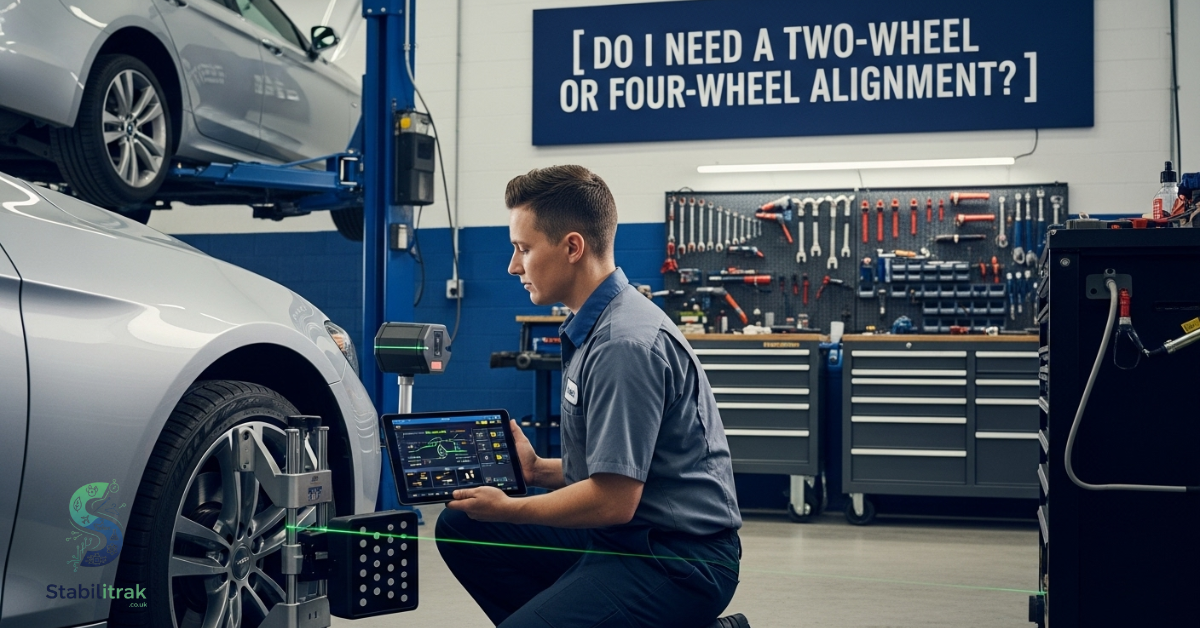
Two-wheel alignments are typically used on front-wheel drive vehicles and are quicker and more affordable. Four-wheel alignments are usually required for all-wheel drive or vehicles with independent suspension to make sure all wheels are properly aligned. Your mechanic will determine which type suits your vehicle for optimal performance and safety.
Can tire alignment cause vibration?
Yes. Misaligned wheels can create vibrations, particularly at high speeds. These vibrations may be felt in the steering wheel, pedals, or seat. Aligning the wheels correctly not only smooths the ride but also reduces stress on suspension components, enhancing long-term durability.
Read More Article: How Long Does an Oil Change Take?
Difference between wheel alignment and tire balancing
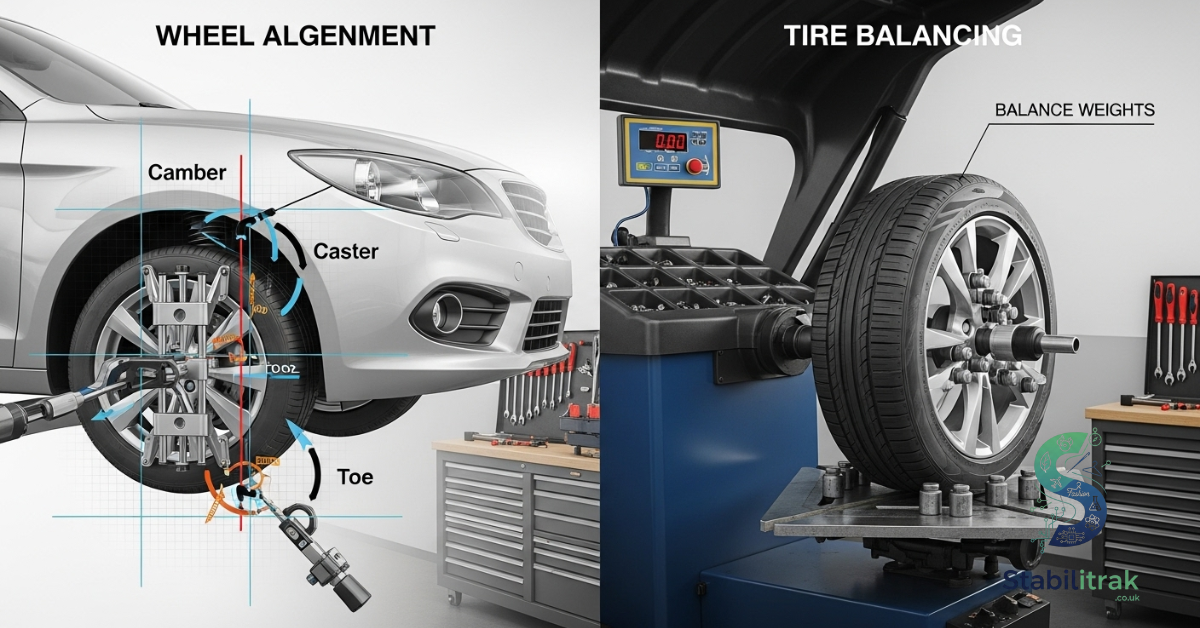
Wheel alignment sets the angles of the wheels to enhance stability and minimize uneven tire wear. Tire balancing, in contrast, corrects weight imbalances across the tire’s circumference. Both are important; alignment corrects wheel positioning, while balancing ensures smooth rotation and minimizes vibration.
Conclusion
Knowing how long an alignment takes and what affects it helps you plan your service appointments without stress. Regular alignment checks improve tire life, handling, ride comfort, and overall vehicle safety. By understanding symptoms, alignment types, and maintenance schedules, you’ll keep your car performing at its best, no matter the road conditions.
FAQs about Wheel Alignment
How long does a 4-wheel alignment take?
4-wheel alignment typically takes about 90 minutes to 2 hours. Time may vary depending on the vehicle type and suspension condition. Additional repairs can extend the process.
How much does an alignment cost?
Alignment costs usually range between $75 and $150 for standard cars. Luxury or heavy-duty vehicles may cost more. Discounts or specials may be available at some shops.
How long does an alignment take for a car?
Most standard car alignments take around 60 to 90 minutes. Two-wheel alignments are quicker, while four-wheel alignments take longer. Vehicle condition and any repairs may affect timing.
How long does an alignment take, Reddit?
On forums like Reddit, users report that alignments typically take 1 to 2 hours. Some vehicles with simple setups finish faster. Complex or high-performance cars can take longer.
How long does an alignment take on a truck?
Truck alignments usually take 90 minutes to 2 hours due to larger suspension systems. Heavy-duty trucks may require more time. The condition of suspension parts can affect the total duration.
How long does a 2-wheel alignment take?
A two-wheel alignment generally takes about 45 to 60 minutes. Front-wheel drive vehicles often use this type. It’s faster than a full four-wheel alignment.
Alignment near me
To find an alignment nearby, search “alignment near me” online or check local mechanics. Most auto shops offer two-wheel and four-wheel services. Compare prices and read reviews before booking.
How does an alignment work?
Alignment adjusts your wheels’ angles, camber, toe, and caster to factory specifications. Technicians use machines with sensors and cameras for precise measurements. Proper alignment improves handling, tire life, and safety.
How much does an alignment cost?
On average, a wheel alignment costs between $75 75to $150, depending on the vehicle type and location.
How long does a 4-wheel alignment take?
A 4-wheel alignment usually takes about 60 to 90 minutes.
How long does an alignment take, Reddit users say?
Most Reddit users report it takes around 1 hour, but it may take longer if extra repairs are needed.
How long does an alignment take for a car?
Typically, a car alignment takes 1 hour, but the time can vary based on the condition.
How long does an alignment take on a truck?
Truck alignments may take 1 to 2 hours since larger vehicles need more adjustments.
How long does a front-wheel alignment take?
A front-wheel alignment usually takes about 30 to 60 minutes.
How long does a 2-wheel alignment take?
A 2-wheel alignment generally takes around 30 to 45 minutes.
How long does an alignment take at Firestone?
At Firestone, expect about 1 hour for a standard alignment, depending on your vehicle. Do you want me to also add a short intro + conclusion so it looks like a proper FAQ section for a blog/website?

